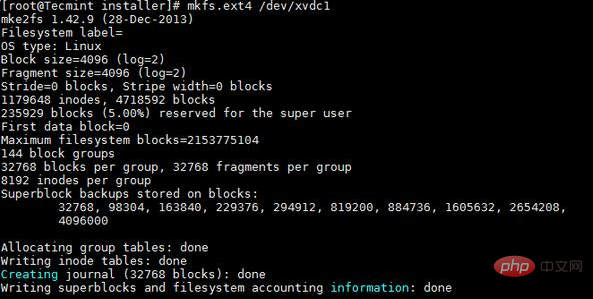How to add a hard disk in linux
How to add a hard disk in Linux: 1. Use the fdisk command to display the current hard disk partition status, and press the "n" key to add a new partition; 2. Use the mkfs command to format the partition; 3. Use the mount command to mount the partition. ;4. Use the "defaults 0 0" statement to set automatic mounting at permanent startup.

#The operating environment of this tutorial: linux7.3 system, Dell G3 computer.
How to add a hard disk in Linux
A hard disk with a capacity of 20GB has been added and mounted to the /data partition.
fdisk is a command line tool used to display and manage hard disks and partitions on Linux systems.
# fdisk -l
This command will list the current partition and configuration.

After adding a 20GB hard drive, the output of fdisk -l is as follows.
# fdisk -l

View new partition details
The newly added disk is displayed as /dev/xvdc. If we were adding a physical disk, it would look like /dev/sda based on the disk type. Here I am using a virtual disk.
To partition on a specific hard drive, such as /dev/xvdc.
# fdisk /dev/xvdc
Commonly used fdisk commands
n - Create partition
p - Print partition table
d - Delete a partition
q -Exit without saving changes
w -Save changes and exit
Since we want to create a partition, use the n option.

Create a primary partition or extended partition. By default we can have up to 4 primary partitions.
Enter the partition number as required. It is recommended to use the default value of 1.
Enter the size of the first sector. If it is a new disk, usually choose the default value. If you are creating a second partition on the same disk, we need to add 1 to the last sector of the previous partition.
Enter the value of the last sector or partition size. It is generally recommended to enter the size of the partition. Always add prefix to prevent value out of range errors.
Save changes and exit.
How to add a new disk on a Linux system How to add a new disk on a Linux system
Save partition changes
Now use the mkfs command to format the disk.
# mkfs.ext4 /dev/xvdc1

Format the new partition
After the formatting is completed, follow the following command to mount the partition.
# mount /dev/xvdc1 /data
Add entries in the /etc/fstab file for automatic mounting on permanent boot.
/dev/xvdc1 /data ext4 defaults 0 0
Related recommendations: "Linux Video Tutorial"
The above is the detailed content of How to add a hard disk in linux. For more information, please follow other related articles on the PHP Chinese website!

Hot AI Tools

Undresser.AI Undress
AI-powered app for creating realistic nude photos

AI Clothes Remover
Online AI tool for removing clothes from photos.

Undress AI Tool
Undress images for free

Clothoff.io
AI clothes remover

AI Hentai Generator
Generate AI Hentai for free.

Hot Article

Hot Tools

Notepad++7.3.1
Easy-to-use and free code editor

SublimeText3 Chinese version
Chinese version, very easy to use

Zend Studio 13.0.1
Powerful PHP integrated development environment

Dreamweaver CS6
Visual web development tools

SublimeText3 Mac version
God-level code editing software (SublimeText3)

Hot Topics
 1378
1378
 52
52
 How to start nginx in Linux
Apr 14, 2025 pm 12:51 PM
How to start nginx in Linux
Apr 14, 2025 pm 12:51 PM
Steps to start Nginx in Linux: Check whether Nginx is installed. Use systemctl start nginx to start the Nginx service. Use systemctl enable nginx to enable automatic startup of Nginx at system startup. Use systemctl status nginx to verify that the startup is successful. Visit http://localhost in a web browser to view the default welcome page.
 How to check whether nginx is started
Apr 14, 2025 pm 01:03 PM
How to check whether nginx is started
Apr 14, 2025 pm 01:03 PM
How to confirm whether Nginx is started: 1. Use the command line: systemctl status nginx (Linux/Unix), netstat -ano | findstr 80 (Windows); 2. Check whether port 80 is open; 3. Check the Nginx startup message in the system log; 4. Use third-party tools, such as Nagios, Zabbix, and Icinga.
 How to start nginx server
Apr 14, 2025 pm 12:27 PM
How to start nginx server
Apr 14, 2025 pm 12:27 PM
Starting an Nginx server requires different steps according to different operating systems: Linux/Unix system: Install the Nginx package (for example, using apt-get or yum). Use systemctl to start an Nginx service (for example, sudo systemctl start nginx). Windows system: Download and install Windows binary files. Start Nginx using the nginx.exe executable (for example, nginx.exe -c conf\nginx.conf). No matter which operating system you use, you can access the server IP
 How to solve nginx304 error
Apr 14, 2025 pm 12:45 PM
How to solve nginx304 error
Apr 14, 2025 pm 12:45 PM
Answer to the question: 304 Not Modified error indicates that the browser has cached the latest resource version of the client request. Solution: 1. Clear the browser cache; 2. Disable the browser cache; 3. Configure Nginx to allow client cache; 4. Check file permissions; 5. Check file hash; 6. Disable CDN or reverse proxy cache; 7. Restart Nginx.
 How to solve nginx403 error
Apr 14, 2025 pm 12:54 PM
How to solve nginx403 error
Apr 14, 2025 pm 12:54 PM
The server does not have permission to access the requested resource, resulting in a nginx 403 error. Solutions include: Check file permissions. Check the .htaccess configuration. Check nginx configuration. Configure SELinux permissions. Check the firewall rules. Troubleshoot other causes such as browser problems, server failures, or other possible errors.
 How to check whether nginx is started?
Apr 14, 2025 pm 12:48 PM
How to check whether nginx is started?
Apr 14, 2025 pm 12:48 PM
In Linux, use the following command to check whether Nginx is started: systemctl status nginx judges based on the command output: If "Active: active (running)" is displayed, Nginx is started. If "Active: inactive (dead)" is displayed, Nginx is stopped.
 How to clean nginx error log
Apr 14, 2025 pm 12:21 PM
How to clean nginx error log
Apr 14, 2025 pm 12:21 PM
The error log is located in /var/log/nginx (Linux) or /usr/local/var/log/nginx (macOS). Use the command line to clean up the steps: 1. Back up the original log; 2. Create an empty file as a new log; 3. Restart the Nginx service. Automatic cleaning can also be used with third-party tools such as logrotate or configured.
 Difference between centos and ubuntu
Apr 14, 2025 pm 09:09 PM
Difference between centos and ubuntu
Apr 14, 2025 pm 09:09 PM
The key differences between CentOS and Ubuntu are: origin (CentOS originates from Red Hat, for enterprises; Ubuntu originates from Debian, for individuals), package management (CentOS uses yum, focusing on stability; Ubuntu uses apt, for high update frequency), support cycle (CentOS provides 10 years of support, Ubuntu provides 5 years of LTS support), community support (CentOS focuses on stability, Ubuntu provides a wide range of tutorials and documents), uses (CentOS is biased towards servers, Ubuntu is suitable for servers and desktops), other differences include installation simplicity (CentOS is thin)




